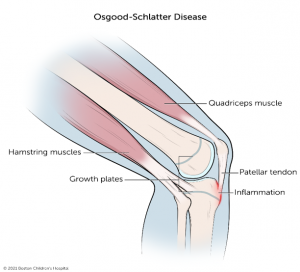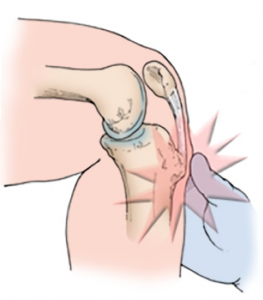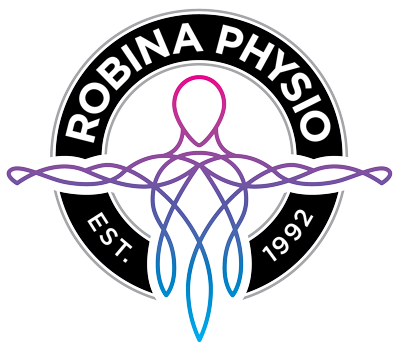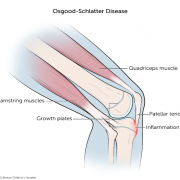Osgood-Schlatter Disease
Osgood-Schlatter Disease
By Jonathan ‘Yona’ Dorfzaun, Physiotherapist.
Osgood-Schlatter Disease (OSD) is a common cause of anterior knee pain in adolescents and young adults who are still skeletally immature. OSD usually develops during adolescence between ages 10 to 15 years for males and 8 to 13 years for females. It is more common in boys than in girls and it often presents during significant growth spurts.
OSD (Osgood-Schlatter’s Disease) usually manifests without any specific trauma or injury. Instead, it develops as gradual anterior knee pain, often accompanied by tenderness at the bottom of the kneecap and on the bony area at the top of the shin, where the patellar tendon attaches to the tibial tuberosity (refer to the picture below). The condition is typically a result of repetitive stress activities like jumping and sprinting. Common sports associated with Osgood-Schlatter’s include Athletics, Netball, Basketball, Volleyball, Gymnastics, Tennis, and various Football codes. Additionally, in 20% to 30% of patients we see in clinic, symptoms can affect both legs.
Beyond rapid growth spurts, other factors that can contribute to the condition are poor flexibility of the quadriceps and hamstrings muscles, as well as incorrect alignment of the knee during activities such as walking, running, jumping, kicking, or cycling.
What will you feel?
Most cases of Osgood-Schlatter’s Disease (OSD) are characterized by increased anterior knee pain, with or without swelling, which intensifies during physical activities like running, jumping, cycling, kneeling, walking up and down stairs, and kicking a ball.
One significant indicator of OSD is tenderness upon touching the bony part at the top of the shin, known as the tibial tuberosity. In certain instances, the tibial tuberosity might undergo growth, leading to the noticeable presence of a lump. It’s crucial to note that the size of this bony prominence does not necessarily correlate with better or worse outcomes of the condition. Additionally, individuals with OSD may experience tightness in the front and back of their thighs and could even feel a sense of heaviness in their legs by the end of the day.

OSD predominantly arises as an overuse injury, often becoming apparent after activity or an increase in physical demands. The repetitive strain and microtrauma endured during these activities lead to irritation of the growth plates situated at the top of the shin, specifically at the bony part called the tibial tubercle apophysis. Pain typically indicates irritation of these growth plates. While severe cases may occasionally result in partial avulsion or fracture, such occurrences are rare. X-rays are not routinely necessary, but in severe cases where a fracture or avulsion is suspected, they might be considered.
It’s essential to recognise that Osgood-Schlatter disease can present similarly to several other knee injuries, including Sinding-Larsen-Johansson Syndrome, Patello-femoral Joint Syndrome, and Patella Tendinopathy. Hence, if your child experiences new-onset knee pain, seeking professional medical advice from reputable practitioners like those at Robina Physio on the Gold Coast is highly recommended. An accurate diagnosis made early on and a well-structured treatment plan can ensure effective management of the condition.
Treatment
At Robina Physio on the Gold Coast, our comprehensive treatment plan would typically encompass various approaches to effectively manage your symptoms. We may utilise techniques such as massage, stretching, dry needling, and/or ice therapy to alleviate discomfort and promote healing. Additionally, we would focus on activity modification to minimise activities that aggravate your condition, allowing your body the necessary time to heal through relative rest. Our goal is to provide you with a tailored and holistic treatment plan that addresses your specific needs and facilitates a smooth recovery.

During your physiotherapy sessions at Robina Physio on the Gold Coast, the primary goal is to discover the optimal balance, that “sweet spot,” where you, as an athlete, can engage in your desired activity or sport with minimal to no pain. Our focus is on effectively managing your running and jumping load in the short term, allowing you to continue participating within the injury’s limits, facilitating the healing process. Complete cessation of activity may not always be the best long-term solution.
We have achieved great success in managing our patients by implementing a comprehensive lower limb mobility, strengthening, and progressive loading program. This approach addresses any stiffness or weakness that contributes to the irritation of the tendon over your kneecap and shin. However, the most crucial aspect of your journey is determining the appropriate level of activity that your body can handle before pain arises.
An essential message we convey to our patients regarding Osgood-Schlatter disease is that it follows a natural progression and is a self-limiting injury. This means that with proper pain management, you can continue with your regular physical activities. Our role is to help you identify the suitable intensity and frequency while also reducing your pain, ensuring a smoother recovery process.
The good news!
Osgood-Schlatter Disease has an excellent prognosis! The condition is self-limiting and acute periods usually recover within a month. However, if unnoticed or untreated pain may persist up to 2 years or when you have stopped growing!
The Physiotherapist’s at Robina Physio on the Gold Coast are here to help with any of your knee injuries, including Osgood-Schlatter Disease. Contact us on (07) 5578 7233 or BOOK ONLINE.



